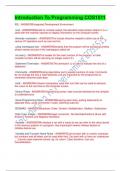Exam (elaborations)
Introduction To Programming COS1511
- Course
- Institution
Introduction To Programming COS1511 IDE - ANSWERSIntegrated Development Environment cout - ANSWERSStands for console output; the standard output stream object in C++; used with the insertion operator to display information on the computer screen #include <iostream> - ANSWERSThe inc...
[Show more]



